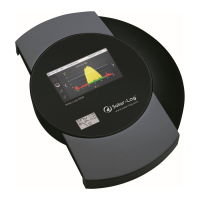166
Configuration Menu
Reductions
The following configuration options are available in the Reductions section.
•
Max. cos(phi) inductive/underexcited and max. cos(phi) capacitive/over-excited:
A maximum shift factor can be defined wit this the reduction. With this, it can be that less reactive
power is fed-in into the grid than allowed in the partial load range in order to maintain the shift
factor limits.
Note!
Entering zero as the value deactivates the particular limit.
16.13.4 Variable cos (Phi) shift factor over characteristic curve P/Pn
The function allows the cos (Phi) to be adjusted according to characteristic curve P/Pn.
With a characteristic curve P/Pn, the ratio of the currently generated power (P) to nominal power (maxi-
mum output) (Pn) is determined. A Cos (Phi) is assigned to ratio by a characteristic curve.
The function is also referred to as Phi (P).
The currently generated power (P) is calculated by the Solar-Log™ based on the inverter data. If an Utility
Meter with power measurement is available, the output value will be used instead.
Note!
Please check that all of the Solar-Logs in a master/slave setup have the same firmware
version, especially for the characteristic curve P/Pn with the Utility Meter.
Type of characteristic curve section
Using this menu item a characteristic curve specified by the grid operator can be stored. In principle a dis-
tinction is made here between a 2-point and a 4-point characteristic curve.
2-point characteristic curve
By selecting “2-point characteristic curve” it is possible to define a characteristic curve using two points.
Procedure
•
Select Variable cos (Phi) shift factor over characteristic curve P/Pn from the menu.
•
Activate the interface assignments to control.
•
Select 2-point characteristic curve.
•
Define the characteristic curve points A and B based on the boxes P/Pn and cos (Phi) and put a
check in front of inductive/under-excited.
•
SAVE the settings.
The characteristic curve displayed changes according to the values entered.

